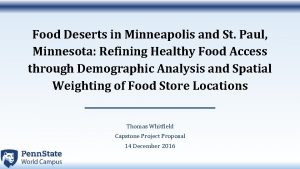www hoddereducation co ukgeographyreview Food deserts in the













- Slides: 13

www. hoddereducation. co. uk/geographyreview Food deserts in the UK Possibilities for NEA investigations David Redfern Hodder & Stoughton © 2019

Introduction This presentation supports the article ‘Food security in Detroit: a case study’, by Timothy Le. Doux, in GEOGRAPHY REVIEW Vol. 32, No. 4, pp. 12– 15. Hodder & Stoughton © 2019

Definition, and factors • A food desert is a neighbourhood where people experience physical and economic barriers to accessing affordable, healthy food. • A food desert can also be viewed as an area of relative exclusion. This can be due to differences in levels of income and/or deprivation. Both of these can impact on car ownership, access to public transport and the cost of public transport. • Other features, such as an elderly population and the difficulties facing people travelling with children in pushchairs, can have an influence. • Some writers have also suggested there could also be an ethnic dimension to the issue. • Disability, affecting physical access, may also play a role. Hodder & Stoughton © 2019

Background In October 2018, a report by the Social Market Foundation (SMF) and Kellogg’s (http: //www. smf. co. uk/publications/barriers-eating-healthily-uk/) found that: • More than 1 million people in the UK live in ‘food deserts’ — neighbourhoods where poverty, poor public transport and a dearth of big supermarkets severely limit access to affordable fresh fruit and vegetables. • Nearly 1 in 10 of the country’s most economically deprived areas are food deserts — typically large out-of-town housing estates and deprived inner-city wards served by a handful of small, relatively expensive corner shops. • Public health experts are concerned that these neighbourhoods, which also often have high densities of fast-food outlets, are helping to fuel a rise in diet-related conditions such as obesity and type-2 diabetes. They are also driving food insecurity. Hodder & Stoughton © 2019

Possible questions/ideas for investigation (1) For a questionnaire/interview on barriers to eating healthily: • What proportion of your household income is spent on food? • Does buying food put a strain on household finances? • Do you consciously shop in a cheaper store? If so, which one, and for what products? • Which foods do you find unaffordable? • Do you find that healthy food (fruit and vegetables) is unaffordable? • How far do you travel to shop? • How do you travel to do your shopping? • What difficulties do you face when travelling to buy food? • How do the above vary according to age, and gender? Hodder & Stoughton © 2019

Possible questions/ideas for investigation (2) For investigating other factors that may impact on eating healthily: • Do smaller convenience stores charge higher prices for some items compared with larger supermarkets? Are there variations within the same supermarket ‘brand’ — for example between a Tesco Metro and a Tesco supermarket? • Are there variations in the above between urban and rural areas? • What is the impact of online grocery deliveries on household food purchases? Are such services used equally across society? Note: none of the questions on these two slides ask about actual household income. This information is personal and you should avoid such questions. Hodder & Stoughton © 2019

Food deserts and walking distances An alternative definition of a food desert is an area in which individuals have to walk more than 500 m to a shop that sells healthy foods. • Research by Dr Hillary Shaw found that in 20% of rural areas and 25% of urban areas in the UK individuals had to walk more than 500 metres to reach a shop selling a good amount of fruit and vegetables. • Retail development policies which have created edge-of-city superstores have resulted in reduced access to food retail provision in poor neighbourhoods — people have to travel further and need access to cars. • Such processes have unevenly stripped food retailing out of some parts of British towns and cities. Hodder & Stoughton © 2019

Mapping (neighbourhood scale) Map from a fieldwork project in a small town showing roads within 500 m of accessing a food shop (circles). Pale areas are food deserts. Hodder & Stoughton © 2019

Mapping (city scale) Fieldwork map of Newcastle-upon-Tyne showing access to shops selling 14 different items of fruit and vegetables. Grey-shaded areas are ‘food deserts’.

Classification of areas in relation to food outlets: • Food desert – an area containing two or fewer supermarkets/convenience stores. • Normal area – an area containing between three and seven supermarkets/convenience stores. • Food oasis – an area containing more than seven supermarkets/convenience stores. • Such categories could be mapped across an urban or rural area. Probably the best scale to use is Middle Super Output Areas (MSOAs). Note: Rural areas are likely to have a more restricted choice of food stores than urban areas. However, rural areas generally have lower levels of economic and social deprivation than urban areas, and car ownership rates tend to be higher – making it easier for individuals to travel greater distances to food stores. But those in rural areas without access to a car, or with restricted mobility (for example due to age or disability) may still encounter difficulties accessing a range of food stores. Hodder & Stoughton © 2019

Relationships between food deserts and takeaways Ideas that could be tested: • Are there more takeaway stores in deprived areas? • Is there a link between takeaway availability and higher rates of obesity in deprived areas? • Do food deserts have above-average numbers of takeaway food outlets? In areas where access to supermarkets and convenience stores are limited, individuals might be more inclined to frequent takeaways on a regular basis. • On the other hand, is it true that food deserts also tend to be ‘takeaway deserts’? Hodder & Stoughton © 2019

Useful weblinks Guardian article from October 2018: ‘More than a million UK residents live in 'food deserts', says study’https: //www. theguardian. com/society/2018/oct/12/more-than-amillion-uk-residents-live-in-food-deserts-says-study Guardian article from July 2017: ‘Large rise in takeaway shops highlights dominance of fast food in deprived areas’ https: //www. theguardian. com/inequality/2017/jul/25/large-rise-takeaway-shopshighlights-dominance-fast-food-deprived-areas-england Sky News story from January 2019: ‘Obesity crisis: The UK's weight problem in seven charts’ https: //news. sky. com/story/seven-charts-on-the-uks-obesity-problem 11583981 Hodder & Stoughton © 2019

This resource is part of GEOGRAPHY REVIEW, a magazine written for A-level students by subject experts. To subscribe to the full magazine go to: http: //www. hoddereducation. co. uk/geographyreview Hodder & Stoughton © 2019
























